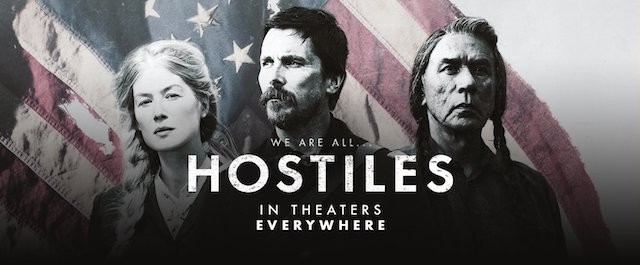Plagued by an awkward release schedule, “Hostiles” provides an honest commentary on white nationalism and cruelty found in both oppressors and the oppressed. Grounded by stellar performances, this Oscar-snub yields intense action and a thought-provoking theme.
INTENSE EXECUTION
“Hostiles” proves tense and violent throughout. Set in New Mexico in 1892, it begins with the murder of a young family by a Comanche war party leaving the matriarch Rosalie Quaid, portrayed by Rosamund Pike, alone and distraught. It then quickly cuts to the capture and beating of a Native American family by Army Captain Joseph Blocker, portrayed by Christian Bale. The United States president then assigns Blocker the task of escorting a dying Cheyenne chief named Yellow Hawk, portrayed by Wes Studi, and his family to Montana so that he may die at home. Yellow Hawk and his family have been prisoners in New Mexico for seven years and as a reparation for this cruelty, the government has granted them freedom. Blocker and an Army detail reluctantly escort the Cheyenne family, Rosalie and some stragglers to Montana but face danger at every turn.
Every action sequence enthralls as the brilliant sound design and choreography provide the audience with full immersion into the film. Whereas many action scenes allow for a fun escape, director Scott Cooperdoes an excellent job of letting the action sequences progress the plot by revealing more of our protagonist’s savagery. Though it may come across as boring, the film brings crucial exposition and character development by slowing down in between action sequences. The cinematography should also be lauded as the film showcases beautiful landscapes, which truly brings the viewer to the Midwest.
The stellar performances of the cast remains the highlight of this film. Bale’s subdued performance as a stoic and damaged man only proves his maturity and superiority as an actor. Pike also gives what may be her best performance since “Gone Girl” through raw, yet tamed emotion. Although broken, Pike’s character shows resilience and strength and acts as much more than a mere damsel in distress. These two gritty performances are grounded in reality, which allows for more relatability from the audience. The supporting cast also acts well with standout performances from Jesse Plemons, whose naivety brings depth, and Ben Foster, whose surprise appearance provides important exposition. The technical execution of “Hostiles” proves excellent, barring some slow and contrived scenes.
THOUGHT PROVOKING THEME
“Hostiles” provides a dour film with glimpses of light. Blocker represents a man pushed beyond his breaking point into depravity and rage, ultimately showing that he has become just as “savage” as the people he hates. The film makes it clear that savagery lies within both sides, and death and depravity can consume anyone.
This opens up conversations about the immorality within ourselves and how we must prevent it from consuming our souls. Unfortunately, the evil in this world can be all-consuming, but for some innate reason, Blocker finds it within himself to forgive those he hates so he may find peace within himself proving that no man is too far gone.
The movie also stirs up conversations about white nationalism and how these early roots of violence have affected marginalized Americans today. Some characters in “Hostiles” mention that white Americans are truly the oppressor and the Native Americans are just defending themselves as they were here first. This gives basis today for conversations about the mistreatment of Native Americans and for conversations about the mistreatment of any minority in America today.
Cooper’s “Hostiles” provides a violent and honest look at the depravity within man and provides a good platform for debate and discussion of race and rage among all.








